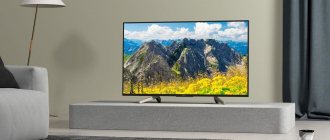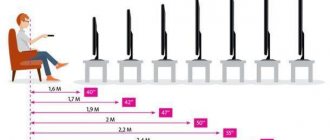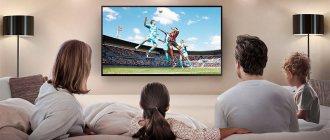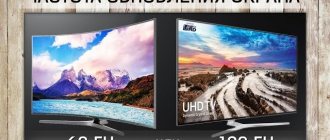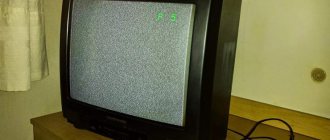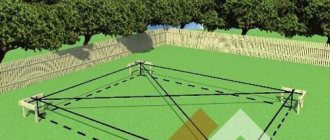When going to the electronics supermarket, users sincerely believe that the larger the screen diagonal, the better. This is wrong. The quality of the broadcast image is determined by completely different parameters. A huge screen will not look harmonious in a small room. A large display size can negatively affect viewing comfort. How to choose the TV diagonal? There are clear criteria that allow you to select a TV in accordance with the size of the room in which it will be located.
How to choose a good TV?
At first glance, to choose the ideal TV model, you need to take into account a dozen parameters. However, it is enough to decide on the key characteristics, and the choice becomes much easier.
What should you pay attention to?
- The diagonal of a TV is the main parameter on which the physical dimensions of the device depend;
- Screen resolution - determines the clarity of the image;
- Screen technology – responsible for the depth and quality of color rendering;
- Supported interfaces - the more there are, the more devices the TV can interact with;
- Smart TV and additional features - diversify your TV use.
Let's look at these points in more detail.
What are the dangers of making the wrong choice?
If you choose a TV that is too small or, on the contrary, large, disaster will not happen. However, over time you will begin to notice that:
- Your eyes become more tired when watching TV. Because the picture is too voluminous, the eyes will be affected by extreme brightness and contrast. At the same time, if the screen is too small, you will have to strain your eyesight.
- The image quality leaves much to be desired. This happens when you sit too close to a screen with a low resolution.
- Watching TV is not very convenient. If the display is too close, you won't be able to take in the entire image with your eyes, so you'll find yourself turning your head from side to side regularly.
When choosing a TV for your home, utmost attention is paid to the screen diagonal size. To choose a suitable display, calculate the correct distance from the viewer to the device, and also take into account the features of the room and the quality characteristics of the TV.
Screen diagonal
This is the distance between the far opposite corners of the TV. The larger it is, the larger the TV. Usually measured in inches. How to choose the TV diagonal? It is often advised to think in advance from what distance the new TV will be watched. This recommendation dates back to the era of cathode ray picture tubes, when sitting too close to the screen was harmful to vision due to powerful electromagnetic fields and the flicker effect. Today it is not relevant - all modern TVs can be safely watched from any distance (of course, without fanaticism). Therefore, choose a diagonal based on the future location of the TV in the interior and your financial capabilities. For example, models with a diagonal up to:
- 24″ are ideal for wall mounting in small kitchens;
- 32″ will be convenient for tabletop use in small bedrooms and living rooms;
- 43″ will fit into standard-sized rooms;
- 50″ for large rooms and halls;
- 55″ and above will help equip a home theater.
Simply put, if your interior and finances allow you, it is better to give preference to TVs with a larger diagonal.
Distance and diagonal correspondence table
For convenience, the ratio of diagonal and distance to the viewing point were grouped in the table.
| Display diagonal | Distance |
| 17 inches (43.2 cm) | 1.2 m |
| 25 inches (63.5 cm) | 1.9 m |
| 32 inches (81.3 cm) | 2.4 m |
| 40 inches (101.6 cm) | 3m |
| 48 inches (121.9 cm) | 3.6 m |
| 55 inches (139.7 cm) | 4.1 m |
| 80 inches (203 cm) | 6 m. |
Screen resolution
Much more important than the diagonal is the resolution of the TV screen. The fact is that any image is built from pixels - small dots that convey one color. The more such dots on the screen, the clearer the image will be. High-definition TVs can be viewed even from close distances, and you will not see the grain in the picture. Screen resolution is related to its diagonal: the larger the diagonal, the higher the resolution should be. Based on resolution, TVs are divided into:
- HD (1366×768) - ideal for small screens, up to 32" diagonal. On large HD screens, the picture will be noticeably grainy up close.
- Full HD (1920×1080) is the most common resolution today. Well suited for large diagonals.
- 4K or UltraHD (3840×2160) - this resolution today provides the highest quality image. Used in TVs with standard and large diagonals (from 40"). However, such models are quite expensive.
To summarize what has been said, if there is a choice between diagonal/resolution, we advise you to buy a TV, albeit with smaller dimensions, but with a higher resolution.
Features of choice
Calculating the diagonal of a TV is extremely important, but this process may be subject to certain changes according to the type of screen. This parameter directly affects the quality of the broadcast image. CRT models have long been considered a relic of the past. Therefore, we will concentrate on the most common options today.
LED TV is a liquid crystal matrix. The lighting system consists of miniature LEDs. This technology is considered extremely effective. It provides the deepest color possible. LED panels guarantee high-quality color reproduction in a wide range, and also significantly expand viewing angles. You can watch this TV anywhere in the room within a range of up to 180 degrees from the display side.
OLED TVs are distinguished by the fact that each pixel is individually illuminated. The technology allows you to achieve high-quality contrast images with color rendering in the range of 2-5 nanometers. High image refresh rates improve LED technology by approximately 200 times. Even when showing dynamic scenes, there is no blurring effect.
Consider the distance when choosing the TV diagonal. However, LED and OLED technologies are 100% harmless to the visual system. Therefore, the distance from the screen to the viewing point is not of fundamental importance.
How to choose a TV according to the size and shape of the screen? The diagonal will depend on the room in which the device is located. As for the form, there are certain nuances. Today, stores offer a wide range of both curved and traditional flat models. Each option has its own specific advantages and disadvantages. However, curved TVs are much more expensive.
Support for HDR technology is another point that should be taken into account when choosing technology. This standard has higher brightness. On the screen, the viewer will see the most natural image possible. Therefore, if possible, then buy a model that supports this technology.
Now let's talk about how to choose a TV size. The calculation of the optimal size is carried out in accordance with a special formula. So that all users understand how to get the optimal value, let's look at a few illustrative examples.
Let's imagine that the client's choice fell on a Full HD TV. The approximate distance between the viewing point and the screen is 2 meters. To get the optimal diagonal, you need to divide the distance of 200 cm by 1.56, and then by 2.54 (to convert to inches). In the end we got 50.4 inches. It is this diagonal that will be considered optimal for a given resolution and distance.
Now let's look at another example. The user buys a model with 4K resolution. This is premium-segment equipment with impressive functionality and elegant design. The distance from the screen to the viewing point will be one and a half meters. Now, using a similar principle, we will calculate the optimal screen diagonal. Divide 100 centimeters by 0.7, and then by 2.54. We get a result of 56.2 inches. This means that the diagonal should vary in the range of 55-60 inches.
Smart TV
This feature turns an ordinary TV into a multifunctional gadget. Using a high-speed connection, it connects to various Internet services as well as other home devices. Essentially, Smart-TV gives the TV the functions of a computer. This is achieved using several operating systems: Android TV (in Philips and Sony) - built on the same principles as in smartphones. Supports many applications, the interface will not cause inconvenience to users. Different TVs may have different versions of this OS installed. Tizen is a Samsung development and is installed on this company’s TVs. All Samsung TVs have the same Tizen version. Many Russian-language applications are supported. Also intuitive for users. WebOS - installed on LG TVs. The functionality is very similar to Tizen. Any of these operating systems is optimized for working with a TV. The only inconvenience for some users may arise from the unusual interface.
Methods for measuring the diagonal of a TV
In general, there are only two ways to find out the diagonal size of your TV. The most correct way is to open the data table. One of the pages should contain this information, and many manufacturers list the dimensions on the TV's factory box.
This information can also be easily found on the Internet, just enter the device model in the search field. Often the manufacturer provides such a distance on the body. But you need to concentrate, because in this situation the number can be in either centimeters or inches.
However, there are various situations in which you need to measure the diagonal of the TV yourself. In this version of events you will need a tape measure, you can use a ruler, but in this case there will be a big mistake. To measure, it is enough to know the distance from the lower left corner to the upper right. If you need to calculate the dimensions in inches, then the resulting number should be divided by 2.54.
Important: only the screen is taken into account, the bezel is not included in the diagonal, so there is no need to measure it.
Some TVs have a curved screen. This makes measuring the diagonal of your TV with a tape measure a real nightmare. To avoid trouble, prepare a regular long string. One end needs to be attached to the bottom left corner and then pulled out to the top right corner. Use your finger to attach the “joint” between the threads and the top corner, then measure the length. The resulting number is diagonal, but in centimeters.
Digital television standard
Several years ago, Belarus completely abandoned analog television (when the signal was transmitted using radio waves) in favor of digital television (the digital signal is encoded in a binary system). This made it possible to ensure good quality of reception throughout the country. All modern televisions contain a built-in digital receiver. Digital television is transmitted according to several standards:
- DVB-T - digital terrestrial television. This standard has been adopted in Belarus for terrestrial broadcasting.
- DVB-C - digital cable television.
- DVB-S - digital satellite television.
In conclusion
Modern TVs can amaze even the most sophisticated users. Every year the image quality becomes better and the functionality becomes more extensive. Therefore, televisions have long ceased to be just a means for watching television. For example, models with an ultra-thin body can be hung on the wall, turning them into live wallpaper! However, in order to use the device comfortably, several nuances must be taken into account when choosing it. One of which is the screen diagonal. Measuring it is not difficult at all - just arm yourself with a tape measure and apply it to the display. Once the necessary data is obtained, all that remains is to find a model with a suitable resolution and aspect ratio. And that’s it – you can safely press the “place an order” button.
Interfaces
The functionality of the TV expands significantly if you connect other digital devices to it. This can be done using various interfaces.
HDMI is a connector for connecting a cable that allows you to transmit high-definition digital data. So, you can connect game consoles, computers, and other multimedia devices to the TV. The bandwidth depends on the HDMI version:
- HDMI 1.4 – capable of transmitting 4K video at 30 KHz;
- HDMI 2.0 - 60 KHz;
- HDMI 2.1 - 120 KHz;
USB allows you to connect a flash drive, external hard drive and other media to the TV to view content. Bluetooth - using a wireless connection you can connect a smartphone, tablet, keyboard, mouse and other devices. WI-FI - provides a wireless connection to the TV from the Internet. Ethernet - wired Internet for TV. With a cable connection, the network signal contains less interference and the connection speed is higher.
Complex geometry
You can also measure the diagonal of your TV in cm using the simple school method, knowing the length and height of the visible area of the screen. The process itself is a little simpler than with a diagonal, because you are dealing with real objects - the horizontal and vertical straight edge of the display. Do this using a tape measure or ruler. You can also use a short ruler, laying it down one at a time, making small marks with a pencil.
So, you have numbers horizontally, for example, 75 and vertically, 35. The squares of these numbers are 5625 and 1225. Many people cannot do without a calculator). And the sum of squares is 6.850. All that remains is to take root. We get a number of 82.7 cm. Divide it by the inch size - 2.54 and get 32.58. Yes, the diagonal of the TV is slightly more than 32 inches.
By the way, if you don’t have a convenient calculator (oh, every smartphone now has one and, of course, every Windows computer), we suggest using a convenient online service that quickly calculates the diagonal itself if you enter the width and height of the display in the appropriate fields.
Additional options and features
Let's talk a little about things that will make the use of the TV more diverse, but which you can do without.
Camcorder
TVs with SMART-TV are often equipped with a video camera. With its help, you can communicate with friends using applications and social networks, record videos without a computer or smartphone, use gesture control and augmented reality (depending on the capabilities of a particular TV).
Voice control
Another common component of SMART-TV. Allows you to control your TV, search for content, launch programs, etc. using voice commands.
Curved screen
As additional features, some manufacturers offer TVs with a slightly concave screen. It is believed that this creates the effect of presence, the picture is better perceived by peripheral vision. There is no experimental confirmation of this.
Response time
This is the amount of time it takes for one pixel to change its displayed color tone. As a rule, for most models it varies between 1-8 ms. This parameter is most often paid attention to by console lovers who use the TV as a monitor for games, as well as viewers of dynamic films and sports competitions, where the picture changes very quickly. Insufficient response time leads to a blurring effect. However, all modern TVs in a class higher than budget ones do not have this drawback, and manufacturers often do not indicate this parameter at all in the characteristics.
Viewing angle
You've probably noticed that if you look at the LCD monitor from the side, the image darkens and the color changes. OLED and QLED TVs, where the viewing angle reaches 178°, do not know this drawback. In our opinion, this is an insignificant parameter, because people usually don’t watch TV from the side.
Why is the diagonal measured in inches?
Before we look at how the diagonal of a TV is measured, it is important to understand what inches are and why they are used to characterize screens. So, an inch is a unit of measurement for non-metric length.
1 inch = 2.5 centimeters. In ancient times, an inch was measured by the length of the second phalanx of the thumb of an adult male of standard build. Today, this unit of measurement is practically not used, with the exception of some industries of the Russian Federation and the sizes of televisions and computer monitors. In Western countries, the inch is called "in" or "inch".
TV screens traditionally have diagonal dimensions rather than panel length and width. There are several reasons for this phenomenon:
- Older televisions used a cathode ray tube, a special round tube, to display images on the screens. The diagonal of the image was equal to the diagonal of the CRT, so this parameter was more important than the length or width of the screen.
- Modern LCD monitors have a standard aspect ratio of 4:3 or 16:9, so one variable is enough to determine the size of the TV panel.
- The first televisions appeared in the United States of America, which, as you know, does not use the classical metric system of measurement. For this reason, the screen diagonal was first specified in inches, which has since been adopted and spread throughout the world.
Nowadays, inches are commonly used to indicate the specifications of various electronic devices supplied to the international market.
A short checklist for choosing a TV
- Appearance
Modern models have become so elegant that people no longer want to hide them deep into the “walls”, but on the contrary, they want to show them off. You can easily choose a model that is both functional and to your liking. There are even picture TVs, whose displays occupy 99% of the front panel area and have a body only 15 mm thick. They can be attached to the wall or placed on an easel stand.
- Size
The larger the screen, the better. After all, it is he who is able to provide the most “exciting” picture and give the viewer a feeling of presence.
- Permission
It’s the same with size: the higher it is, the more comfortable it is when viewing. The optimal option is 4K (displays 8 million pixels - just imagine the scale!).
- HDR or Wide Dynamic Range support
With this function, the image literally moves to a new level: the contrast between dark and light objects in the frame improves dramatically, the tones become as close to real as possible, and in dark scenes you will see all, even the smallest, details.
- Sound
If there is no high-quality sound, then the most beautiful picture will not please you. Check the number and location of speakers, find out if there is a noise reduction and automatic tuning function.
- Additional functions
They add to the price, but damn, how nice it is to use Internet services via fast Wi-Fi, or connect to your computer via Remote Access!
Which backlight should you choose?
3 types of backlight have been developed: Direct LED (FALD), Edge LED/LIT and OLED.
- Direct LED (FALD) - direct backlight installed on cheap models (UJ634V from LG, E-Series/ D-Series from Vizio). In this case, the LEDs are evenly installed behind the monitor, and the emitter is directed towards the user. Bright points have a halo effect, and in addition, the accuracy of darkening localization is rather weak.
- Edge LED/LIT is available on most 4K TVs. Pros: relatively high brightness, good contrast, uniform black color. Cons: highlights are clearly visible at the edges of the monitor, and unevenness is noticeable in the overall picture.
- OLED is a modern technology that uses organic light-emitting diodes (they are self-emitting, so the screen does not require backlighting). There are many advantages: firstly, the dimensions and weight of the model are reduced due to the small thickness of the screen, secondly, energy is consumed wisely, thirdly, there are no distortions in viewing angles, fourthly, the contrast and brightness are impeccable. There are only 2 disadvantages: the first is that these kinds of LEDs of individual colors do not work for long, the second is that there is a display burn-in effect (by the way, the latest models provide dynamic shift, so this disadvantage has practically disappeared).
How high should you hang your TV?
We've sorted out the distance and location, but what about the height? At what height should you hang the TV so that your eyes and neck don’t mind prolonged viewing? Remember the first row of a cinema; it’s not for nothing that tickets there are usually cheaper. Sitting the entire session with your head thrown back and looking at the giant faces of the characters is such a pleasure.
The most comfortable viewing position is when your eyes are level with the center of the screen (movie theaters know a lot about ticket pricing). If we talk about the average sofa in the average apartment, then the distance from the floor to the eye level of a sitting person is approximately 1 meter. Most often, furniture sets and TV stands are made with just this in mind. But if you decide to use only a bracket to attach the TV to the wall, sit down and measure the required distance. Then you will thank yourself.
